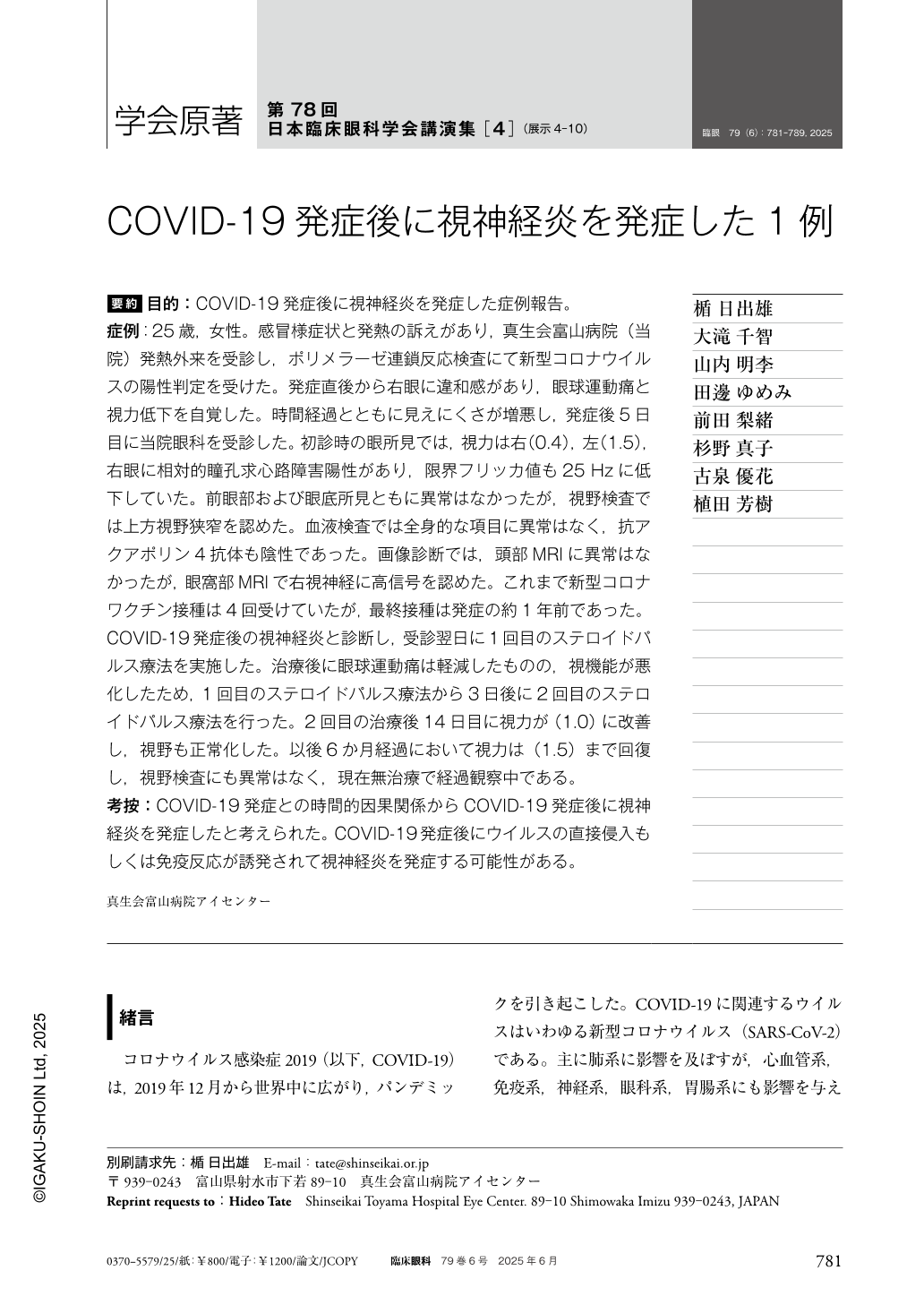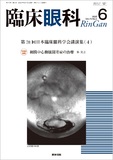Japanese
English
- 有料閲覧
- Abstract 文献概要
- 1ページ目 Look Inside
- 参考文献 Reference
要約 目的:COVID-19発症後に視神経炎を発症した症例報告。
症例:25歳,女性。感冒様症状と発熱の訴えがあり,真生会富山病院(当院)発熱外来を受診し,ポリメラーゼ連鎖反応検査にて新型コロナウイルスの陽性判定を受けた。発症直後から右眼に違和感があり,眼球運動痛と視力低下を自覚した。時間経過とともに見えにくさが増悪し,発症後5日目に当院眼科を受診した。初診時の眼所見では,視力は右(0.4),左(1.5),右眼に相対的瞳孔求心路障害陽性があり,限界フリッカ値も25Hzに低下していた。前眼部および眼底所見ともに異常はなかったが,視野検査では上方視野狭窄を認めた。血液検査では全身的な項目に異常はなく,抗アクアポリン4抗体も陰性であった。画像診断では,頭部MRIに異常はなかったが,眼窩部MRIで右視神経に高信号を認めた。これまで新型コロナワクチン接種は4回受けていたが,最終接種は発症の約1年前であった。COVID-19発症後の視神経炎と診断し,受診翌日に1回目のステロイドパルス療法を実施した。治療後に眼球運動痛は軽減したものの,視機能が悪化したため,1回目のステロイドパルス療法から3日後に2回目のステロイドパルス療法を行った。2回目の治療後14日目に視力が(1.0)に改善し,視野も正常化した。以後6か月経過において視力は(1.5)まで回復し,視野検査にも異常はなく,現在無治療で経過観察中である。
考按:COVID-19発症との時間的因果関係からCOVID-19発症後に視神経炎を発症したと考えられた。COVID-19発症後にウイルスの直接侵入もしくは免疫反応が誘発されて視神経炎を発症する可能性がある。
Abstract Purpose:To report a case of optic neuritis after COVID-19 infection.
Case report:A 25-year-old female patient presented to our outpatient fever clinic with cold-like symptoms and fever. She presented to our outpatient fever clinic with complaints of common cold-like symptoms and fever, and tested positive for COVID-19 by polymerase chain reaction(PCR)test. After the infection, she felt discomfort in her right eye and was aware of ocular motility pain and vision loss. Her difficulty seeing worsened over time, and she visited our department on the fifth day after infection. On initial examination, visual acuity was 0.4 in the right eye and 1.5 in the left eye, with positive RAPD in the right eye, and CFF decreased to 25 Hz. Both anterior and fundus findings were normal, but visual field testing showed upper visual field constriction. Blood tests revealed no abnormalities in systemic parameters, and anti-aquaporin 4 antibody was negative. Imaging examination revealed no abnormality on head MRI, but orbital MRI showed high signal in the optic nerve of the right eye. The patient had received four previous corona vaccinations, the last one a year before infection, and was diagnosed with optic neuritis following COVID-19 infection, and the first steroid pulse therapy was administered the day after the patient's visit. After treatment, ocular motility pain decreased, but visual function worsened, so a second steroid pulse therapy was given 3 days after the first. 14 days after the second treatment, visual acuity improved to 1.0 and visual field normalized. Six months later, her visual acuity had recovered to 1.5, and her visual field tests were normal.
Discussion:The temporal causal relationship with post-COVID-19 infection suggested that the patient developed optic neuritis after COVID-19 infection, which could be caused by direct viral invasion or induced immune response after COVID-19 infection.

Copyright © 2025, Igaku-Shoin Ltd. All rights reserved.


